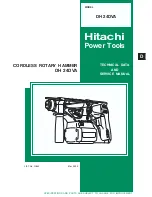
6
7
GB
GB
angle then rotate the Mode selector to the Hammer setting.
5. Check that the bit is secured in place. It should not be able to be pulled out of the Chuck.
Chisel Operation
1. Adjust the Auxiliary Handle as needed.
2. Plug in the Power Cord.
3. Squeeze and hold the Trigger to turn on the Rotary Hammer.
4. Allow the Rotary Hammer to reach full speed before contacting the work surface.
5. When finished, to prevent accidents, release the Trigger and disconnect its power supply after use. Pull
back on the Chuck then remove the bit from the Chuck. Clean, then store the tool indoors out of children’s
reach.
CLEANING AND MAINTANCE
Maintenance and Servicing
! Procedures not specifically explained in this manual must be performed only by a qualified technician.
WARNING
TO PREVENT SERIOUS INJURY FROM ACCIDENTAL OPERATION:
Release the Trigger and unplug the tool from its electrical outlet before performing any inspection,
maintenance, or cleaning procedures.
TO PREVENT SERIOUS INJURY FROM TOOL FAILURE:
Do not use damaged equipment. If abnormal noise or vibration occurs, have the problem corrected before
further use.
Cleaning, Maintenance, and Lubrication
1. BEFORE EACH USE, inspect the general condition of the tool. Check for loose hardware, misalignment or
binding of moving parts, cracked or broken parts, damaged electrical wiring, and any other condition that
may affect its safe operation.
2. Monthly, open the Grease Port, clean out old grease, and replace with new grease.
3. AFTER USE, wipe external surfaces of the tool with clean cloth.
4. Lubricate the bit shank with grease each time before installing to maintain the life of the internal
mechanism.
5. WARNING! If the supply cord of this power tool is damaged, it must be replaced only by a qualified
service technician.
NOTICE:
Warranty void if grease maintenance (internal and bit shank) is not followed.
ENVIRONMENT
Do not dispose of electric tools, accessories and packaging together with household waste material
- in observance of European Directive 2002/96/EC on waste of electric and electronic equipment and its
implementation in accordance with national law, electric tools that have reached the end of their life must
be collected separately and returned to an environmentally compatible recycling facility.
TROUBLE SHOOTING
Fault Symptom
Possible Cause
Troubleshooting
Out of service
Disconnection between plug and
power socket
Put plug in power socket
shortcircuit in power supply
Repair and reconnection
At switch-off
Switch on
Loose switching contact
Replace switchboard by repairer
Burnout of stator or rotor coil
Replace stator or rotor by repairer
Wearout of carbon brush
Replace carbon brush by repairer
Stator wiring disconnection
Reconnection by repairer
Disconnection between carbon
brush and commutator
Replace carbon brush
Sluggish start-up, falling
short of running speed
Unsmooth running in mechanical
part
Check mechanical part by repairer
Low supply voltage
Regulate supply voltage
Burnout of switch contact
Replace switchboard by repairer
Excessive sparkling during
running
Underpressure in carbon brush
spring
Replace carbon brush by reparier
Excessive wearout of carbon brush Replace carbon brush by reparier
Overvoltage in supply power
Regulate supply voltage
Disconnection between carbon
brush and commutator
Replace carbon brush
Ring fire caused by shortcircuit in
rotor winding shortcircuit
Check or replace rotor by repairer
Ring fire caused by shortcircuit in
commutator segment
Check or replace rotor by repairer
Failed to reach rated power
Electrocircuit overload due to
lighting device, public utility or
other electric appliances
No use of public utility or other electric
appliances on machine-connected
electrocircuit
Machine superheating
Electromotor overload
Overload protection
Excessive blunt drilling bit
Replace drilling bit
Insufficient lubricating oil or greasy
lubricating oil in reduction gearbox
Replenish or replace lubricating oil by
repairer
Insufficient motor cooling
Dedust air outlet
Gear shifting failure
Shifting fork or bearing damaged
Check and replace shifting fork or bearing
by repairer
Failure of mechanical shock
motion
Air cylinder or teleflex damaged
Check and replace air cylinder or teleflex
by repairer
Wearout of O-shape coil
Replace O-shape coil by repairer
Piston fracture or insufficient
lubricating oil
Replace piston or replenish lubricating oil
by repairer
Chock liner gets stuck
Repair chock liner by repairer
Disconnected running of spline
shaft or swinging bearing by
repairer
Replace spine shaft or swinging bearing
by repairer
Piston connecting rod fracture
Replace piston connecting rod by repairer
No motion of drilling bit
during motor running
Rotor tooth fracture
Replace rotor by repairer
Gear wheel fracture
Replace gear wheel by repairer
Clutch gear slippage
Replace clutch gear by repairer
Spare parts list and drawing Please download files on
www.maxpro-tools.com
Summary of Contents for 111-0904
Page 24: ...42 43 RU RU 85 A 1 a b c 2 a b c d e f 3 a b c d e f g 4 a b c d e f...
Page 27: ...48 49 RU RU o o www maxpro tools com...
Page 32: ...59 FA 58 O O 96 EC 2002 1 2 3 4 5 FA...
Page 33: ...61 FA FA 1 2 3 4 1 2 3 4 1 1 4 1 2 3 4 5 6 1 2 3 4 5 6 1 2 3 4 5 1 2 3 4 5 60 4...
Page 34: ...62 63 FA FA 16 13 Maxpro orpxaM 16 230 240 220 FA Release Button 2 3...
Page 36: ...AR AR 7 4 5 5 66 67...
Page 37: ...AR AR 7 4 5 1 2 3 4 1 2 3 4 1 1 4 1 2 3 4 5 6 1 2 3 4 5 6 1 2 3 4 5 1 2 3 4 5 1 2 3 4 68 69 4...
Page 38: ...AR 1 2 3 3 8 3 8 6 71 70 2 3...
Page 40: ...www maxpro tools com...





























